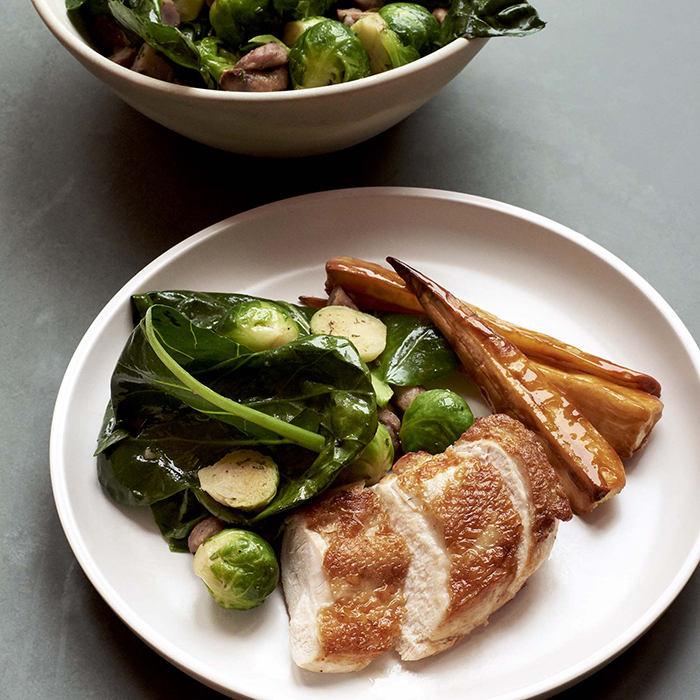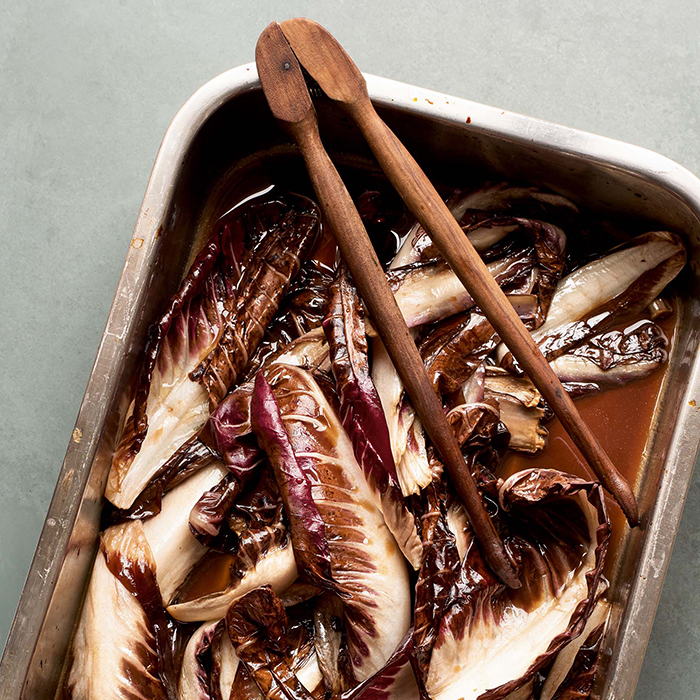Consider the trimmings
Author: Guest Blogger

Pictures taken from On the Side by Ed Smith (Bloomsbury, £20). Photography: Joe Woodhouse
Are you agonising over what wines to uncork this Christmas? Perhaps you think that decision rests with the question of whether it’s turkey, rib of beef, or goose this year?
Here’s a controversial suggestion: you’ve got your priorities wrong. Of course you should be thinking about which wine to serve over the feasting period – but the “centrepiece” meats are, in fact, the least important part of your meal. They’re dull. Always the same. And they’ll probably be overcooked, so hardly something to hang the hooch on.
Really, it’s the trimmings that matter: the stuffing, roast spuds, greens and bread sauce that you’ll be going back to for seconds. These things – “the sides” – don’t just make up the majority of your plate, they’re also the bits that ensure the Christmas meal is greater than the sum of its parts (or any meal, for that matter). So surely it’s with the peripherals in mind that a wine should be chosen?
Yes, it’s a complex area: there’s lots going on around the fringe, and people always aim for far too many sides and sauces (six, seven or more is really three or four too many). But some of those can, and should be, simple supporting acts, leaving one or two star-sides to take the lead.
It doesn’t take much to make sprouts more interesting than the over-boiled, sulphurous orbs of our youth – roast them and season with celery salt and piles of black pepper, or blanch and then fry them with rosemary, bacon and chestnuts.
Perhaps you could make the carrots stand out this time, braising them in Riesling and dill, or tossing them in browned butter, lemon, hazelnuts and parsley at the last minute?
Maybe it’s the turn of the parsnip to be the hero – years ago, Delia pushed Parmesan onto them, my cookbook, On the Side (sorry, this is, in part, a sales pitch), humbly suggests you ought to toss them, once roasted, in a honey and Marmite glaze. It’s addictive, honest. But needs careful thought on the drinking front.
You could even consider something beyond the typical veg, like the recipe for baked radicchio with a buttery Pedro Ximénez sauce below. It’s a truly brilliant accompaniment to roast beef, and something that’ll make turkey fly, for once.
Making sure your sides are at least well selected, if not the starting point for your meal plan, is a matter that extends beyond the Christmas meal (great sides are for life, etc etc…). There’s no point, for example, perfecting the glazed ham, if you haven’t also made sure the boulangère potatoes and braised red cabbage with beetroot match up. Do you always have a venison stew over the festive period? Then you should consider a new way with celeriac, and/or juniper butter cabbage to go with it (in the book, of course).
It’s those kinds of details that will make Christmas eating a success. And it’s only once you know which direction those sides are taking things, that you can get down to the serious business of choosing what to drink alongside.

Pictures taken from On the Side by Ed Smith (Bloomsbury, £20). Photography: Joe Woodhouse
You can use any type of radicchio here, or even red chicory, though I think Trevisano works best (and also takes a little longer than the others to cook). Those glorious burgundy leaves wilt and turn brown. More appealingly, they also soften in texture, mellow in flavour and yield some of their own juices while soaking up the toffee, coffee and chocolate notes of Pedro Ximénez. It’s a particularly grand side next to game birds, pigeon and rich beef dishes, and I suspect you’ll enjoy it with white fish and wild mushrooms as well; a little bit naughty and a touch lavish but, like all things with these qualities, very desirable.
- 1-2 heads (about 500g) radicchio Trevisano
- 70ml Pedro Ximénez Sherry
- 50g butter
- Sea salt and freshly ground black pepper
Preheat the oven to 200 ̊C/Fan 180 ̊C/Gas 6.
Separate the radicchio leaves by cutting off the base to loosen them. Wash them in cold water and drain briefly, leaving a little water clinging to the leaves. Put them in a small roasting tin, making sure they’re no more than 2 or 3 leaves deep.
Pour the Pedro Ximénez and 50ml water over the top, mixing to ensure all the leaves are coated. Sprinkle with a generous pinch of salt and a grind or two of black pepper, then dot the butter on top of the leaves. Make a cartouche by wetting a piece of greaseproof paper a touch bigger than the roasting tin, scrunching it up, then unravelling it, placing it over the leaves and tucking it in around the edge.
Bake in the middle of the oven for 30 minutes, stirring the leaves and replacing the cartouche every 10 minutes, to make sure none of the leaves dry out.
The leaves will brown and soften and start giving off a coffee smell. When that’s happened, remove them from the oven and transfer to a serving dish. Pour the cooking juices over the top and let the leaves absorb their bath for 5 minutes before serving. Make sure everyone takes both leaves and sauce when helping themselves.
Browse our seasonal collection of wines and spirits on bbr.com.
Ed Smith is the author of On the Side, a sourcebook of inspiring side dishes (Bloomsbury, £20) and the influential food blog www.rocketandsquash.com. He writes for a variety of publications and organisations, including Borough Market, the FT Weekend Magazine and the Guardian. @RocketandSquash


